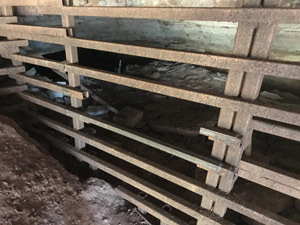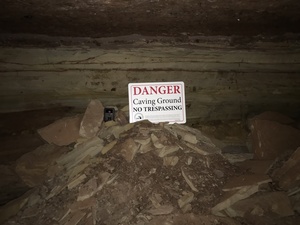
Conservation officers are investigating a break-in and theft of security cameras and signs from a mine site on private property near the city of Norway where an important bat research project has been under way.
The old abandoned iron mine – a small, dead-end horizontal shaft where the ceiling partially collapsed in recent months – was once the annual winter hibernating home to more than 20,000 little brown, northern long-eared and big brown bats.
“Today, the number of bats hibernating in this mine has fallen to just a few thousand survivors with the advent of white-nose syndrome,” said Bill Scullon, a Michigan Department of Natural Resources Wildlife Division field operations supervisor from the Norway office. “White-nose syndrome is a devastating disease that has killed millions of bats in eastern North America and has significantly impacted Michigan’s bat population.
“These bats eat lots of insects in the summertime and are of great benefit to the environment, forest health and agriculture.”
The mine is gated with a metal structure to keep the public out but protect the bats. The site is also posted against trespass. Those who entered the site illegally disrupted hibernating bats.
DNR wildlife biologists have been working with researchers from Ball State University in Muncie, Indiana and Western Michigan University in Kalamazoo to field test a treatment for bats and mines in the western Upper Peninsula, in hopes of developing an effective compound to combat white-nose syndrome.
Last December, researchers entered the mine and treated the bats with a test compound. Last week, they returned to assess the results.

“Someone broke into the site over the winter,” Scullon said. “They disturbed the bats, stole some of our cameras and signs, had a bonfire and damaged the gating structure. They compromised our research project designed to help save the bats. Survival of these bats is critical to the recovery of their species.”
Not all the cameras at the site were removed by the thief or thieves. The signs taken were unique, with only a handful made by the DNR. They read “Danger – Caving Ground – No Trespassing.”
Evidence was collected at the scene.
“We think someone out there may be able to help us find out who is responsible for this damage and theft,” said Brian Bacon, a DNR conservation officer investigating the incident. “We urge anyone who knows anything that might be helpful in our investigation to contact our toll-free Report All Poaching hotline.”
The mine was vandalized sometime between Dec. 1, 2017 and March 23, 2018. The mine gate was also breached similarly in 2015.
Tips to the hotline may be left anonymously. In some cases, depending on the incident and the value of the information provided, rewards are offered. Operators on the RAP line are available 24 hours, seven days a week.
Since 2006, researchers have confirmed white-nose syndrome in bats in more than 29 states, including Michigan, along with six Canadian provinces.
If disturbed, infected hibernating bats burn up their fat reserves prematurely, using energy needed for the winter.
With no insects available to feed on, and stored fat diminished, these bats die.
White-nose syndrome is not only fatal to little brown bats, but at least a half-dozen other species, including the U.P.’s big brown bats and northern long-eared bats.
To reach the DNR’s Report All Poaching hotline call or text 1-800-292-7800.
 Keweenaw Report Your Source for Local News and Sports
Keweenaw Report Your Source for Local News and Sports





